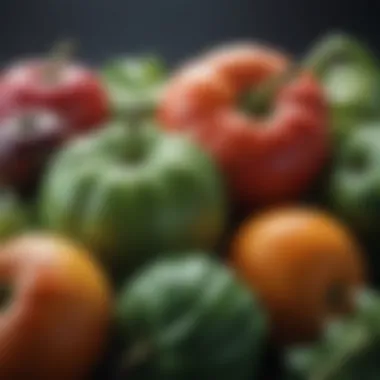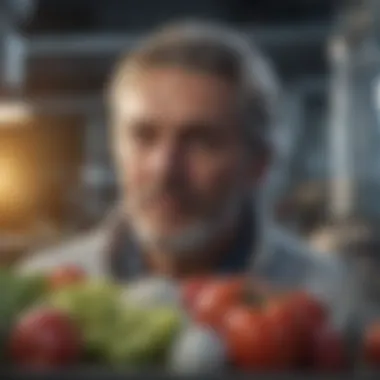The Process and Benefits of Cryogenic Food Freezing


Intro
Cryogenic food freezing is an advanced technique that leverages extremely low temperatures to preserve food. As the agricultural industry navigates challenges such as food waste and the need for longer shelf life, understanding this method becomes critical. This article aims to dissect the concept, historical context, modern applications, and the significant benefits of cryogenic freezing.
Key Concepts and Terminology
Basic Definitions
Cryogenic food freezing involves cooling food to temperatures below -150 degrees Fahrenheit. This process arrests microbial activity and reduces enzymatic reactions, ensuring that the food retains its taste, texture, and nutritional value over extended periods.
Historical Context
The origins of cryogenic freezing can be traced back to the mid-20th century when scientists sought better methods for food preservation. Traditional freezing methods were often inadequate, leading to quality issues. As a result, researchers began to explore the potential of liquid nitrogen and other cryogens in preserving food with minimal damage. This marked a significant shift in food technology, paving the way for its adoption in various sectors.
Recent Innovations and Trends
Technological Advancements
In recent years, several innovations have emerged in the field of cryogenic food freezing. These include improvements in equipment efficiency, like faster freezers that enhance production capacity. Automation in controlling freezing rates has also advanced, offering more precise outcomes. Such developments are making this method more feasible for storage and transportation.
Sustainable Practices
As sustainability gains importance in agriculture, cryogenic freezing stands out due to its efficiency. For instance, liquid nitrogen usage minimizes energy consumption. Additionally, preserving food quality leads to less waste, aligning with global sustainability goals.
Practical Applications and Techniques
Step-by-step Guides
- Preparation: Select fresh produce or prepared meals for freezing. Ensure that the items are cleaned and cut into appropriate sizes.
- Blanching: For some vegetables, blanching before freezing can enhance color and nutrients. This step varies depending on the food type.
- Freezing: Place food in a cryogenic freezer that uses liquid nitrogen or other cryogenic media.
- Storage: Store the effectively frozen items in insulated packaging to avoid sublimation and damage.
Case Studies
In the food service industry, companies like Surgeon's Food utilize cryogenic freezing for seafood preservation. This technique allows them to serve high-quality meals that maintain freshness and appeal to discerning palates.
"Cryogenic freezing is not just a preservation method; it is a pathway to sustainable food systems that respond to modern challenges."
By analyzing its process and benefits, this article will provide valuable insights into the viability of cryogenic food freezing in enhancing food sustainability and quality.
Prolusion to Cryogenic Food Freezing
Cryogenic food freezing is not just a method but a pivotal technique that plays a role in modern food preservation. The significance of cryogenic freezing lies in its ability to maintain the integrity of food products through extreme cold temperatures. This advanced freezing process halts the degradation of food quality and nutritional value. The need for effective food preservation is amplifying, especially in the face of global food waste and sustainability challenges. With food supplies under ever-greater strain, understanding the impact of cryogenic freezing becomes essential for farmers and food enthusiasts alike.
Definition and Overview
Cryogenic food freezing involves the use of ultra-low temperatures, typically below -150 degrees Fahrenheit. This process is distinct from traditional freezing, where food is simply cooled down to near 0 degrees Fahrenheit. In cryogenic freezing, the rapid drop in temperature prevents the formation of large ice crystals within the food. These ice crystals can damage cell structures, leading to loss of texture and quality upon thawing. Therefore, cryogenic freezing preserves the original characteristics of the food more effectively. The method utilizes cryogenic fluids like liquid nitrogen, which is often applied uniformly to ensure that products are quenched rapidly. This allows for better quality retention throughout the supply chain.
Historical Background
The origins of cryogenic freezing date back to the mid-20th century when the method was first implemented in laboratories for biological samples. Over time, its adoption extended into food preservation. In the late 1960s, commercial use began in Europe and North America, improving the way food products were stored and transported. Early applications helped to preserve seafood and meat, leading to innovations in how these products reached consumers.
Despite initial skepticism regarding cost and technology, advancements made over the decades have solidified cryogenic freezing's place in food science. Today, many agricultural practices and food services rely on this method for ensuring freshness and reducing waste. This history sets the stage for addressing current advancements and applications in the field.
The Science Behind Cryogenic Freezing
Understanding the science behind cryogenic food freezing is essential for recognizing its advantages over traditional food preservation methods. This process depends heavily on principles of thermodynamics and molecular biology. The application of extremely low temperatures significantly alters the behavior of food at a cellular level, impacting its quality, safety, and longevity. By comprehending these scientific components, farmers and food service professionals can better harness this technology for their benefit.
Temperature and Phase Changes


Cryogenic freezing is defined by its extremely low temperatures, often reaching as low as -196 degrees Celsius. This is well below the freezing point of water. At such temperatures, molecular motion comes almost to a halt, thus minimizing the formation of ice crystals within food products. The formation of large ice crystals is detrimental, as it ruptures cell walls, leading to loss of texture and flavor when thawed. Instead, cryogenic freezing encourages the formation of much smaller ice crystals. This preservation technique serves to maintain the food's structure, ensuring that when it is thawed, the product retains its original quality.
To comprehend phase changes during the freezing process, it's imperative to consider the states of matter. Initially, food is in a liquid state, primarily composed of water. Upon exposure to cryogenic temperatures, the water transitions from a liquid to a solid state. This phase change not only protects the food's integrity but also serves as an effective barrier against spoilage and microbial growth.
Mechanisms of Cryopreservation
The mechanisms of cryopreservation relate to how cells respond to extreme cold and how these reactions can be controlled to maximize food quality. When food is frozen using cryogenic methods, it undergoes a rapid cooling process. This accelerates the freezing process significantly compared to conventional methods. The swift temperature drop minimizes the time food spends in the critical range where bacterial growth is most active.
A critical aspect of cryopreservation is the use of cryoprotectants—substances that help protect biological tissue from freezing damage. These agents prevent ice crystal formation within cells, ensuring that the integrity of the food is maintained during the freezing cycle. While cryoprotectants are commonly used in laboratory settings, their principles can likewise be applied to food preservation.
By utilizing both the rapid cooling and suitable cryoprotectants, food is preserved not just in terms of safety but also in freshness. The nutritive content is largely retained, as most enzymes responsible for degradation are rendered inactive in such harsh conditions. Eating food that retains its original quality and nutritional value is important for all consumers, particularly in an agricultural context.
"Understanding the science behind cryogenic food freezing empowers food producers to make more informed decisions in food storage and distribution, ultimately improving product quality and resilience against spoilage."
Advantages of Cryogenic Food Freezing
Cryogenic food freezing offers numerous advantages over traditional freezing methods. This innovative process employs extremely low temperatures to ensure that food retains its quality, nutritional value, and also prolongs shelf life. Each of these benefits is crucial for different sectors, especially agriculture and food service.
Enhanced Food Quality
One primary benefit of cryogenic freezing is the enhancement of food quality. When food is frozen quickly using cryogenic methods, ice crystals formed are significantly smaller than those created during slower freezing processes. Smaller ice crystals lead to less cell damage in the food. As a result, the texture, flavor, and appearance of the food are better preserved after thawing.
Consider high-quality foods such as fruits and vegetables. They suffer less degradation in taste and visual appeal post-freezing. Cryogenic freezing allows farmers to provide better products to consumers, thus improving overall satisfaction and reducing waste.
Moreover, processed goods like meat and fish also show improved sensory properties after cryogenic freezing. The moisture retention during freezing helps maintain juiciness and tenderness. In industries focused on high-quality offerings, such as gourmet restaurants, this method becomes an essential practice to meet customer expectations.
Prolonged Shelf Life
Cryogenic freezing also significantly prolongs the shelf life of various food products. The extremely low temperatures used in this process inhibit the growth of microorganisms and enzymes responsible for spoilage. This is particularly beneficial in agricultural practices where seasonal produce can be stored effectively without losing freshness.
Extended shelf life translates into economic advantages for producers and distributors. They can manage inventory more efficiently, reducing the potential for loss due to spoilage. Additionally, consumers benefit from being able to purchase products that remain fresh for longer periods. This aspect plays a vital role in reducing food waste and promotes sustainability in food production and consumption.
"The ability to store food longer translates to lower costs and better resource management, making cryogenic freezing an attractive option for businesses in the food sector."
Nutritional Retention
Nutritional retention is another key advantage of cryogenic food freezing. Many traditional freezing methods can lead to the loss of essential vitamins and minerals, particularly in fruits and vegetables. However, the rapid freezing process utilized in cryogenics retains these nutrients effectively.
Research indicates that foods preserved using cryogenic techniques often maintain higher levels of vitamin C and other vital nutrients compared to those preserved through slower methods. This is especially important for health-conscious consumers who prioritize nutrition in their diet.
Applications in Agriculture and Food Service
Cryogenic food freezing holds significant promise for the agriculture and food service industries. This innovative preservation method not only prevents spoilage but also maximizes the quality of food products. With climate change and increasing demands for sustainable food practices, understanding these applications is critical for modern practices.
Food Preservation for Farmers
Farmers face the challenge of ensuring that their produce remains fresh from harvest to market. Cryogenic freezing offers a reliable solution by rapidly lowering the temperature of crops. This method minimizes the formation of ice crystals, which can damage the cellular structure of fruits and vegetables.
- Advantages for farmers include:
- Extended freshness: With cryogenic preservation, produce can be stored longer without losing its flavor or nutritional value.
- Reduced wastage: This technology helps to decrease the amount of food that must be discarded due to spoilage.
- Accessibility: Farmers can transport their products over longer distances, making their goods available in markets far beyond their local areas.
Supply Chain Management
In today’s global market, effective supply chain management is crucial. Cryogenic food freezing plays a vital role in maintaining the integrity of food products during transport. By freezing items at extremely low temperatures, the risk of spoilage significantly reduces.
Key benefits include:


- Consistency in quality: Food products retain their original texture, taste, and nutritional content during shipping.
- Increased efficiency: Cryogenic systems can operate continuously, allowing for high-volume preservation in a shorter time frame.
- Traceability: Modern technologies integrated into supply chains can monitor the conditions during transport, ensuring that the food arrives in optimal condition.
Restoration of Food Products
The restoration of food products becomes essential in cases where food may have degraded or undergone partial thawing. Cryogenic freezing can be applied to reclaim these items, allowing businesses to minimize losses. This process can be especially beneficial in restaurants and catering services where large quantities of ingredients are needed.
- Benefits include:
- Reduced financial loss: By restoring food products, businesses can avoid unnecessary waste and ensure they remain profitable.
- Versatility: Frozen items can be repurposed in various dishes, thus expanding menu options or offering new products to consumers.
- Sustainable practices: Using technology to restore food aligns with eco-friendly efforts and promotes more responsible consumption.
"Cryogenic freezing is not just a mechanism for preservation, it's a transformative approach to redefining food sustainability across various sectors." - Agriculture Expert
Technological Advancements in Cryogenic Freezing
Technological advancements in cryogenic food freezing represent a pivotal development in food preservation techniques. These innovations enhance the overall efficiency and effectiveness of the cryogenic process. As food quality and sustainability become increasingly crucial in modern agriculture, these advancements are essential for meeting the growing demands of the market.
Automated Cryogenic Systems
Automated cryogenic systems form a key aspect of contemporary freezing methods. These systems reduce the need for manual labor, increasing efficiency significantly. Through automation, the process becomes more standardized, which is vital for maintaining consistent quality in food products.
Key Benefits of Automated Systems:
- Cost Efficiency: Lower operational costs can be achieved by minimizing wastage and labor requirements.
- Enhanced Precision: Automation allows for tighter temperature control, which is crucial for preserving food integrity.
- Real-time Monitoring: Advanced technologies enable the monitoring of freezing processes in real-time, ensuring quick responses to any deviations that might compromise food quality.
As systems improve, automated cryogenic technology allows companies to scale their operations without sacrificing quality. Manufacturers can implement these systems to streamline their workflows, making it easier to manage large volumes of products while ensuring their long-term shelf life.
Mobile Cryogenic Units
Mobile cryogenic units bring a new dimension to food preservation. These units are particularly advantageous for farmers and businesses that may not have easy access to traditional freezing facilities. They provide flexibility and mobility, allowing producers to freeze products directly at the point of harvest.
Highlights of Mobile Units:
- On-Site Freezing: This capability allows for immediate processing of fresh produce, drastically reducing the time from field to freeze.
- Reduced Transportation Costs: By freezing on-site, producers can avoid the costs and risks associated with transporting perishable goods.
- Adaptable to Various Locations: Farms or temporary markets can utilize these units, making them ideal for seasonal businesses.
Mobile cryogenic units ensure that the nutritional quality of food is preserved right from its source. As the urgency for sustainability increases, these innovative solutions are setting a new standard for food handling in agriculture.
"The integration of technological advancements in cryogenic freezing is reshaping how we think about food preservation and quality."
With the advancements in cryogenic freezing technology, the future of food preservation looks promising. The continued investment in research and development can lead to even more groundbreaking innovations in this field.
Environmental Impact of Cryogenic Freezing
Understanding the environmental impact of cryogenic food freezing is critical as we navigate the complexities of sustainable food practices. This section will assess both the advantages and considerations associated with the use of cryogenic technology in the food industry. The need for effective food preservation methods is compounded by growing concerns regarding food waste and energy consumption. Cryogenic freezing, through its precision and efficiency, offers a potential pathway toward minimizing these environmental challenges.
Energy Consumption
Cryogenic freezing systems require significant energy, particularly during the process of cooling food to extremely low temperatures. However, this energy use needs to be contextualized within the broader framework of food preservation. The initial energy expenditure may lead to long-term energy savings by reducing food spoilage and increasing shelf life.
- Efficiency of Technology: Modern cryogenic technologies have become more energy-efficient through innovations such as optimized insulation and improved refrigeration cycles. These advancements contribute to lowering the overall carbon footprint of the freezing process.
- Comparative Footprint: When compared to traditional freezing methods, cryogenic techniques often result in less energy needed per volume of food preserved, especially when considering the scale of food production and distribution.
In the end, while energy consumption remains a concern, the long-term benefits and developments in technology can mitigate these effects significantly.
Waste Reduction Strategies
The issue of food waste is a pressing global concern, with estimates suggesting that approximately one-third of all food produced for human consumption is wasted. Cryogenic freezing serves as a solution to reduce this waste effectively.


- Extended Shelf Life: By using low temperatures, cryogenic freezing preserves food for extended periods without compromising quality. This expanded shelf life is a crucial advantage in reducing food spoilage.
- Inventory Management: Farmers and suppliers can manage their inventory more efficiently. By freezing surplus food items, they can ensure that excess produce does not go to waste, contributing to a more sustainable distribution process.
- Resource Conservation: Reducing waste also has significant implications for resource conservation. Less food waste means lesser need for agricultural inputs, land use, and water resources, which are often poured into growing food that ultimately never reaches consumers.
Cryogenic freezing not only preserves food but also plays a vital role in minimizing waste and optimizing resource efficiency in agriculture.
Challenges in Implementing Cryogenic Freezing
The implementation of cryogenic food freezing presents distinct challenges that require careful consideration. Understanding these challenges is crucial for anyone involved in agriculture and food service. Tackling these issues effectively can lead to substantial gains in food preservation and quality. This section delves into the cost factors and the necessary skills and training that influence the adoption of cryogenic freezing.
Cost Factors
One of the primary challenges in implementing cryogenic freezing is the cost associated with the equipment and technology. The initial investment for cryogenic systems can be significant. Equipment such as liquid nitrogen tanks and insulated freezing units often comes with a high price tag. Moreover, ongoing operating costs must be accounted for, including:
- Liquid Nitrogen Supply: Regular replenishment of liquid nitrogen can substantially increase operational costs, especially for businesses experiencing high turnover of frozen products.
- Maintenance: High-tech machinery often requires specialized maintenance, which can further tax financial resources.
- Energy Costs: While cryogenic freezing can maintain process efficiency, the energy consumed in maintaining extremely low temperatures can impact long-term profitability.
These factors can pose challenges for smaller operations or those with tight budgets. However, despite these costs, the long-term benefits can outweigh the initial investment, making it essential for businesses to conduct thorough cost-benefit analyses.
Skills and Training Requirements
Implementing cryogenic freezing also necessitates a well-trained workforce. Staff must possess specific skills to operate and maintain cryogenic equipment safely. This often involves:
- Understanding of Cryogenic Chemistry: Workers need to be knowledgeable about the properties of cryogenic substances and how they affect food.
- Operational Training: Training programs must cover not only the equipment but also safety procedures required when handling liquid nitrogen, a substance that can cause severe frostbite with improper handling.
- Continuous Education: As technology evolves, workers must stay informed on the latest advancements in cryogenic freezing technology to optimize processes.
Ensuring that staff are well-trained can significantly affect the successful implementation of cryogenic food freezing. Organizations may find that investing in professional development leads to better safety, efficiency, and ultimately, product quality.
Investing in training and development is essential to effectively harness the benefits of cryogenic food freezing.
Future Trends in Cryogenic Food Freezing
The field of cryogenic food freezing is experiencing rapid changes. It addresses many challenges in food preservation and caters to growing demands in agriculture and food service. Understanding future trends in this domain is essential. These trends not only enhance food quality but also contribute to sustainability.
Innovations in Freezing Technology
Recent innovations in freezing technology significantly improve current practices. Advances like nitrogen freezing systems allow for faster freezing, which minimizes the formation of ice crystals. This is vital, as large ice crystals can detrimentally affect food texture. More automated systems are making it easier for industry players to adopt cryogenic methods. This optimization reduces human error and improves efficiency in processing.
Other developments include cryogenic liquid applications, which offer precision in temperature control. This can be beneficial for sensitive products like fruits and vegetables. Combining these technologies with data analytics helps predict optimal freezing conditions tailored to specific food items.
Market Expansion and Adoption
The market for cryogenic food freezing is expanding. As more consumers become aware of the benefits of cryogenic techniques, demand rises. Many restaurants and food companies are adopting this method due to improved shelf life and quality retention of frozen goods. This trend is also evident in agricultural practices. Farmers are seeing the benefits of preserving harvests at ultra-low temperatures.
The rising shift towards sustainability encourages this adoption. As the food supply chain looks for ways to minimize waste, cryogenic food freezing offers a practical solution. Market players recognize that investing in cryogenic technology may yield long-term savings and increased consumer satisfaction.
"Market trends indicate a clear movement towards embracing innovative food preservation methods, essential for a sustainable future."
Concluding Remarks
In this article, we addressed the intricacies of cryogenic food freezing, focusing on its significance in food preservation and quality enhancement. Understanding this technology is crucial, particularly for agriculture farmers and those involved in the food industry. Cryogenic freezing not only improves food quality but also extends shelf life, ensuring that fresh produce retains its nutritional value over time.
Summary of Findings
Cryogenic food freezing operates by rapidly lowering food temperatures using liquid nitrogen or other cryogenic agents. This method minimizes ice crystal formation, which can damage cell structures, leading to deterioration of quality. The historical background demonstrates how this technology evolved from basic freezing methods to sophisticated systems ensuring maximum preservation.
Key points discussed in this article include:
- Enhanced quality: Foods retain texture and taste better than traditional freezing.
- Prolonged shelf life: Ability to store products for extended periods reduces waste.
- Nutritional benefits: Higher retention of vitamins and minerals compared to other methods.
Implications for the Future
The future of cryogenic food freezing indicates a potential for wider adoption among farmers and food suppliers. As technological advancements continue to improve the efficiency of cryogenic systems, barriers related to cost and operational complexity are likely to diminish. Furthermore, the increasing emphasis on food sustainability will likely drive demand for processes that enhance preservation while minimizing environmental impact.
The relationship between cryogenic food freezing and sustainable agriculture is critical. By adopting cryogenic methods, farmers can maintain food quality from farm to table, thereby addressing issues of spoilage and waste. As we move forward, investing in training and technical support for farmers will be essential to fully realize the advantages of this technology.
Investing in cryogenic technology may offer substantial returns not just in profits but also in sustainability efforts, setting a standard for future practices in food preservation.















